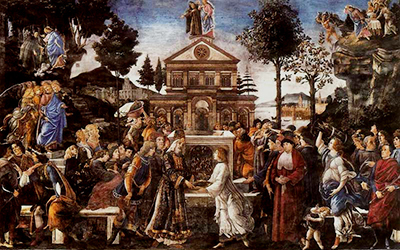The Temptations of Christ is one of several frescos by Sandro Botticelli that now reside in the Sistine Chapel
Artist Botticelli was brought in, alongside other famous Florentine artists of that time, in order to put together a series of work which was aimed at drawing together two powerful rulers.
The Papal States of Italy, as it was known then, was a far from stable region. States were constantly seeking to gain an advantage over each other and enter into agreements with others in order to do so. Botticelli was to become entangled in this political web when Florence and Rome were to seek closer ties.
The original title of this painting was Tentaciones de Cristo and it was completed by Botticelli, with help from some of his assistants, around 1480-1482. This large overall project also required the services of Domenico Ghirlandaio and Cosimo Rosselli, two other notable names from Florentine art at during the Early Renaissance. Another famous name, Pietro Perugino, was actually already there prior to their arrival.
Lorenzo de Medici and Pope Sixtus IV were the two figures behind this agreement and no artist would have had the confidence to turn any request from them down. Many commissions would come from similar circles and so it was unwise to upset anyone within that, otherwise risking future work.
The overall series was intended to draw comparisons between the lives of Moses and Christ, with each artwork forming an element of the final group of works. In suggesting a close tie between the Old and New Testament, relationships would be boosted.
This particular painting features three episodes, covering the left, centre and right of the composition. This layout is used throughout his work in this extensive project. The content covers episodes from the life of Jesus in the Gospels, with Moses getting a similar treatment in an accompanying piece.




